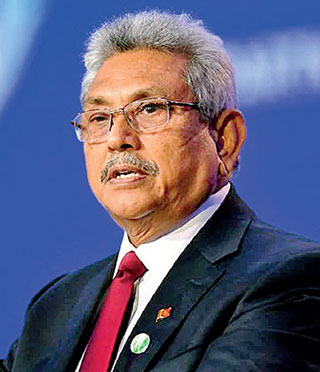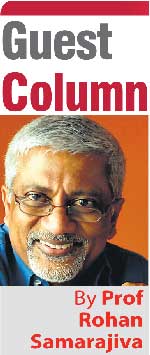Friday Oct 31, 2025
Friday Oct 31, 2025
Tuesday, 13 December 2022 00:31 - - {{hitsCtrl.values.hits}}

President Ranil Wickremesinghe

Former President Gotabaya Rajapaksa

PUCSL Chairman Janaka Ratnayake

The now reversed provisions of the 20th Amendment to the Constitution gave the President the sole prerogative to appoint persons to critically important positions in the upper levels of the state. It was almost a miracle that these pernicious powers were taken away within two years by the passing of the 21st Amendment by the same Parliament that approved the 20th. But simply passing a law does not undo the damage done by the former President’s capricious and partisan appointments. How can the damage be undone, without causing more harm?
There is a historical parallel. Under the 1972 Constitution that gave the Prime Minister enormous powers over the judiciary and the public service, Mrs Bandaranaike made several questionable appointments, including the appointment of former SLFP MP to the highest court. President Jayewardene got rid of these appointees by making no provision for the existing Supreme Court to automatically continue in the Court constituted by the 1978 Constitution. What was the greater harm, continuation of the questionable appointments, or the de facto firing of Supreme Court justices?
Questionable appointments under 20A
Prior to the enactment of the 20th Amendment, the Constitutional Council made binding recommendations to the President on three kinds of appointments:
Under the 20th Amendment, the former President made many appointments in all three categories, with no checks and balances. He caused duly appointed persons serving on these Commissions to resign so that he could make his own capricious and partisan appointments. For example, the Public Utilities Commission had five commission members. At most, two vacancies should have arisen during the past two years because the Act, No. 35 of 2002, had set in place staggered appointments whereby only one vacancy would arise in a year and members would have been appointed by possibly different governments, on the recommendation of different Constitutional Councils.
By allowing different political authorities to make appointments of qualified persons as specified in the Act on the recommendation of (possibly different) Constitutional Councils, it was hoped that the work of this independent commission would be elevated above petty political considerations. But like Hugo Chavez of Venezuela who decimated the structures ensuring the independence regulatory authorities, the former President violated the spirit of the statutory design by compelling resignations and making fresh appointments on his own.
The current Chairman of the Public Utilities Commission whose behaviour may result in the demise of the Commission is enjoying the safeguards set out in the Act for a duly appointed Chairman. Section 6(2) provides that “The Minister may remove a member of the Commission from office after an address of Parliament supported by a majority of the total number of members of Parliament (including those not present) has been presented to the Minister for such removal, after compliance with the procedure set out in section 7.” Section 7 sets out the grounds for removal and the procedures that must be followed prior to invoking the Parliamentary procedure. Removal has been intentionally made difficult to safeguard the independence of the Commission.
The problem, however, is that he and the current members were not appointed through the original procedures, but in violation of the spirit of the Act and under a now repealed Constitutional Amendment.
The 21st Amendment addressed the problem of only one class of persons appointed under the sole prerogative of the President: the members of the Commissions specifically mentioned in the Constitution. Their appointments are nullified on the date the 21st Amendment comes into effect, and they hold office only until the Constitutional Council makes fresh recommendations to the President and he acts on them.
The 21st Amendment is silent on the possibly capricious and partisan appointments made in the other two categories mentioned above. The tenure of any judges who were appointed without the procedures that were restored by 21A is untouched. Appointees to independent commissions not listed in the Constitution, however unqualified and unsuitable, are secure.
Remedies?
Not having included provisions to ease out questionable appointees in 21A, there seem few alternatives to assuming that they were duly appointed and have the legitimacy that comes from a proper appointment procedure. But the Chairman of the PUCSL is not staying quietly allowing the above approach to succeed. He is continuing to make dramatic announcements that, if carefully checked against the black-and-white law as set out in the relevant legislation, may be ultra vires. For example, it is unlikely that a tariff decision, once made, can be modified without going through specified procedures, including possibly a hearing, and satisfying the stated criteria.
One remedy is to repeat the procedure used by the President who appointed him, whereby the duly appointed members of the PUCSL were coerced into resigning. The populist pronouncements of the current Chairman appear to be designed to foreclose this option by framing any possible removal as an attack on a regulator on the side the people (or the religious establishments).
The Government also has the option of acting under sections 6 and 7 for which the grounds appear to exist. But it appears that the Government, or at least some members of the Cabinet, are contemplating a third solution, that of putting the PUCSL out of business by creating a new electricity regulatory commission that would be under the Minister’s thumb, thereby wasting years of work spent on building the capacity of the PUCSL. Would this not be a case of cutting off one’s nose to spite one’s face?